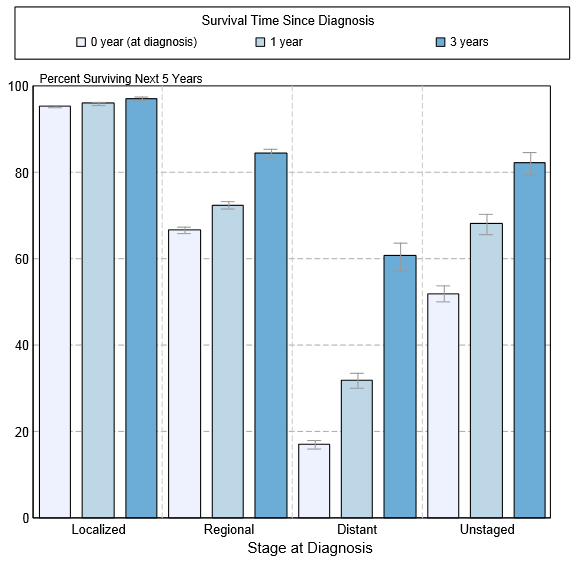Uterine cancer natural history, complications and prognosis
Editor-In-Chief: C. Michael Gibson, M.S., M.D. [1]
|
Uterine cancer Microchapters |
|
Diagnosis |
|---|
|
Treatment |
|
Case Studies |
|
Uterine cancer natural history, complications and prognosis On the Web |
|
American Roentgen Ray Society Images of Uterine cancer natural history, complications and prognosis |
|
FDA on Uterine cancer natural history, complications and prognosis |
|
CDC on Uterine cancer natural history, complications and prognosis |
|
Uterine cancer natural history, complications and prognosis in the news |
|
Blogs on Uterine cancer natural history, complications and prognosis |
|
Risk calculators and risk factors for Uterine cancer natural history, complications and prognosis |
Overview
Natural History
Complications
Complications may include anemia due to blood loss. A perforation (hole) of the uterus may occur during a D and C or endometrial biopsy.
There can also be complications from hysterectomy, radiation, and chemotherapy.
Prognosis
5-Year Survival
- Between 2004 and 2010, the 5-year relative survival of patients with uterine cancer was 83.2%.[1]
- When stratified by age, the 5-year relative survival of patients with uterine cancer was 86.6% and 73.1% for patients <65 and ≥ 65 years of age respectively.[1]
- The survival of patients with uterine cancer varies with the stage of the disease. Shown below is a table depicting the 5-year relative survival by the stage of uterine cancer:[1]
| Stage | 5-year relative survival (%), (2004-2010) |
| All stages | 81.5% |
| Localized | 95.1% |
| Regional | 67.7% |
| Distant | 17,5% |
| Unstaged | 47.9% |
- Shown below is an image depicting the 5-year conditional relative survival (probability of surviving in the next 5-years given the cohort has already survived 0, 1, 3 years) between 1998 and 2010 of uterine cancer by stage at diagnosis according to SEER. These graphs are adapted from SEER: The Surveillance, Epidemiology, and End Results Program of the National Cancer Institute.[1]
References
- ↑ 1.0 1.1 1.2 1.3 Howlader N, Noone AM, Krapcho M, Garshell J, Miller D, Altekruse SF, Kosary CL, Yu M, Ruhl J, Tatalovich Z,Mariotto A, Lewis DR, Chen HS, Feuer EJ, Cronin KA (eds). SEER Cancer Statistics Review, 1975-2011, National Cancer Institute. Bethesda, MD, http://seer.cancer.gov/csr/1975_2011/, based on November 2013 SEER data submission, posted to the SEER web site, April 2014.
